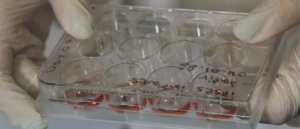Laser-accelerated proton therapy: quickening the pulse of cancer treatment?

Researchers in Germany have, true to form, created an incredibly efficient laser, which they have tested on animals for the first time, marking a proton irradiation milestone in the process.
Maybe George Lucas’ storm troopers would have had a hard time hitting womp rats with their hideous aim, but back on earth, we’re one step closer to bulls-eyeing tumors with our own laser-accelerated protons.
Radiation therapy involves the utilization of focused, powerful x-ray waves to irradiate tumors. Proton therapy is proposed as a more effective and minimally invasive treatment. Here, protons are accelerated into high-energy high-penetration packages delivered deep into the tissue, giving them the ability to transfer most of their energy directly into the tumor. This minimizes the collateral damage to the surrounding tissue while concentrating the impact on the cancer. However, proton therapy requires expensive accelerator facilities to generate the protons and deliver them to the patient. As such, there are only a handful of proton therapy centers compared to x-rays facilities.
With these limitations in mind, the hunt has been on for an alternative, but results thus far have been inconclusive outside of electrons and x-rays, as the range of accelerators capable of delivering ultra-high doses is limited. To address this need, the team led by Helmholtz-Zentrum Dresden-Rossendorf (Dresden, Germany), set about investigating whether proton sources based on laser-plasma acceleration could provide a bridge between x-ray-based therapy and proton therapy.
 Engineered spinal cord implants provide hope for those with traumatic injury
Engineered spinal cord implants provide hope for those with traumatic injury
Using fatty tissue, called adipose tissue, researchers have created an implant that restored movement in both acute and chronic models of paralysis.
For context, researchers have been working on this project for 15 years. The approach involves firing highly concentrated bursts of light at thin plastic or foil. Until recently, the protons had been unable to draw the energy required for irradiation and their unstable pulse intensity meant that researchers could not reliably deliver the correct dose. In recent years, however, improved understanding of laser flash-foil interactions has allowed them to make critical moves forward. Now they have been able to conduct the first irradiation of tumors in mice using these laser-accelerated protons. The experiments were benchmarked against conventional proton therapy experiments.
The results, published in Nature Physics, seemed to indicate that their rapid administration of radiation dose increases the delivery economy to an even greater extent, sparing more surrounding tissue than previous methods. Their method used a high-power laser to generate short but highly intense light pulses.
“Above all, the precise shape of the laser flashes is particularly important. We can now tailor them to create proton pulses that have sufficient energy and are also stable enough,” noted physicist Florian Kroll.
While conventional proton therapy administers the radiation dose over the course of a few minutes, laser-based therapy can be completed within a millionth of a second. To put that in perspective, the adage ‘blink and you’ll miss it’ isn’t even a point of comparison, with the average blink lasting a full third of a second†.
The researchers point to potential applications in tumor irradiation at the base of the skull, the brain, and the central nervous system, with the additional boon in the form of long-term effect reduction.
Naturally, the researchers want to advance on this milestone. Elke Beyreuther commented: “We want to follow up on these indications with our experimental setup and conduct preclinical studies to investigate when and how this rapid irradiation method should be used to gain an advantage in cancer therapy.”





